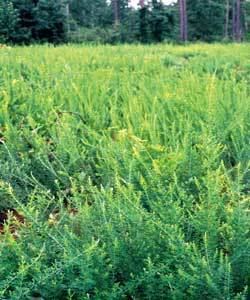Kingdom Plantae Subtribe Lespedezinae | Scientific name Lespedeza Rank Genus | |
 | ||
Lower classifications Lespedeza cuneata, Lespedeza bicolor, Lespedeza thunbergii | ||
Sericea lespedeza
Lespedeza is a genus of some 40 species (including nothospecies) of flowering plants in the pea family (Fabaceae), commonly known as bush clovers or (particularly East Asian species) Japanese clovers (hagi). The genus is native to warm temperate to subtropical regions of eastern North America, eastern and southern Asia and Australasia.
Contents
- Sericea lespedeza
- Bicolor lespedeza project year 2 reality hunt club season 4 webisode 5
- Name of the plant
- Cultivation and uses
- Species
- References

These shrubby plants or trailing vines belong to the "typical" legumes (Faboideae), with the peas and beans, though they are part of another tribe, the Desmodieae. Therein, they are treated as type genus of the smaller subtribe Lespedezinae, which unites the present genus and its presumed closest relatives, Campylotropis and Kummerowia.

Bicolor lespedeza project year 2 reality hunt club season 4 webisode 5
Name of the plant

According to American botanist Asa Gray (1810 – 1888), the Lespedeza owes its name to governor of East Florida Vicente Manuel de Céspedes (1784-1790; who, through a letter, allowed to botanist André Michaux explore the East Florida in search of new species of plants, finding there to the Lespedeza), but when Céspedes wrote the letter, at the beginning of it, the name of Céspedes was changed to "Zespedez". So, when the Michaux´s book Flora Boreali-Americana of 1802 was printed, the name "Céspedes" to refer to the plant was written as "Lespedez", word of which derived the current name of the plant.
Cultivation and uses

Some species are grown as garden or ornamental plants, and are used as a forage crops, notably in the southern United States, and as a means of soil enrichment and for prevention of erosion. In some areas, certain species are invasive. Lespedeza, like other legumes, have root nodules that harbor bacteria capable of nitrogen fixation from the air into a soil-bound form that can be taken up by other plants. Growers can take advantage of this process by putting the plants in their fields to release nitrogen, so they can use less fertilizer.

L. bicolor leaves and roots contain l-methoxy-N,N-dimethyltryptamine (lespedamin), as well as related Nω,Nω-DMTs and their oxides, as well as some bufotenin.
Species
The species and nothospecies recognized in Lespedeza include:
The identity and specific validity of L. schindleri is unclear. In addition, there are some species formerly in this genus that are now placed elsewhere, typically in the Lespedezinae, for example, in genus Campylotropis. These include:
